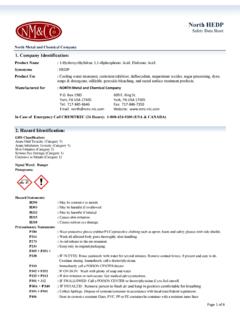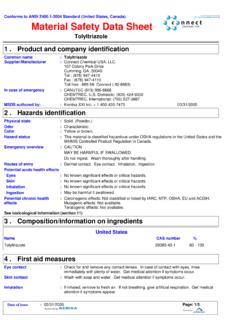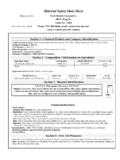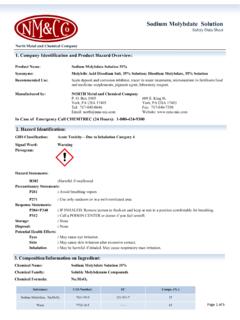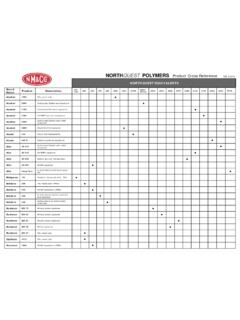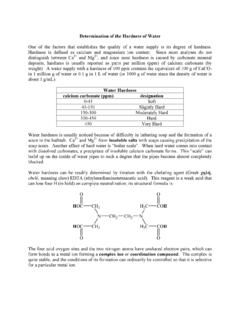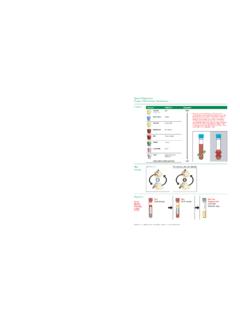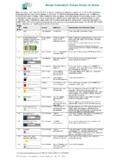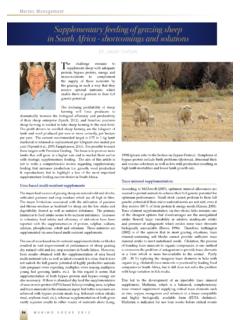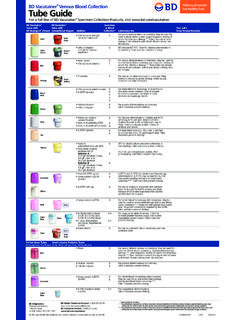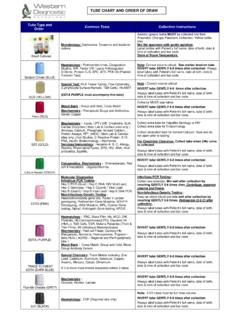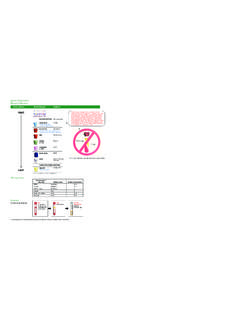Transcription of 1. Company Identification and Product Hazard …
1 1 of 8 NORTH Metal and Chemical Co. versene 220 Crystals Safety Data Sheet 1. Company Identification and Product Hazard Overview: Product Name : versene 220 Crystals Synonyms : N/A Recommended Use : Chelating Agent; sequesters metal ions. Manufactured for : NORTH Metal and Chemical Company P. O. Box 1985 609 E. King St. York, PA USA 17405 York, PA USA 17403 Tel: 717-845-8646 Fax: 717-846-7350 Email: Website: In Case of Emergency: Call CHEMTREC (24H): 1-800-424-9300 2.
2 Hazard Identification : GHS Classification: Acute Toxicity, Inhalation (Category 4) Acute Toxicity, Oral (Category 4) Eye Damage (Category 1) Signal Word: Warning Pictograms: Acute Toxicity Hazard Statements: H333 : May be harmful if inhaled H303 : May be harmful if swallowed H318 : Causes serious eye damage H335 : May cause respiratory irritation Precautionary Statements: P261 : Avoid breathing dust/fume/gas/mist/vapors/spray P264 : Wash contact area thoroughly after handling P271 : Use only outdoors or in a well-ventilated area P280 : Wear protective gloves/protective clothing/eye protection/face protection.
3 P305 + P351 + P338 : IF IN EYES: rinse cautiously with water for several minutes. Remove contact lenses, if present and easy to do. Continue rinsing. P301 + P330 + P331 +P311 : IF SWALLOWED: Rinse mouth. Do NOT induce vomiting. Call a POISON Center or doctor/ physician. P304 + P340 : IF INHALED: Remove person to fresh air and keep in position comfortable for breathing P337 + P313 : If eye irritation persists: Get medical advice/attention P312 : Call a POISON CENTER or doctor/physician if you feel unwell P403 + P235 : Store in a well-ventilated place. Keep cool. P501 : Dispose of contents/container in accordance with local/state/federal regulations.
4 2 of 8 Safety Data Sheet versene 220 3. Composition/Information on Ingredient: Chemical Name : versene 220 Chemical Family : Chelating Agent Chemical Formula : The CAS# 13235-36-4 can also be described for TSCA by CAS# 64-02-8. Substance: CAS Number: EC Compo. (% ) Tetrasodium ethylenediamine tetraacetate Tetrahydrate 13235-36-4 4. First Aid Measures: General Advice: : Consult a physician. Show this safety data sheet to the doctor in attendance. Move out of dangerous area. Eyes : Flush skin with running water for at least fifteen minutes. Remove any contact lenses. Get medical aid/ attention immediately. Continue to rinse eyes during transport to the hospital.
5 Skin : Remove contaminated clothing. Wash skin with plenty of running water and soap. Take victim immediately to the hospital. Consult a physician. Ingestion : If the Product is swallowed, first rinse mouth. Give small amount of water to drink. Call doctor/ physician/poison center immediately. Do not induce vomiting. Never give anything by mouth to an unconscious person. If a person vomits, place him/her in recovery position so the vomit does not enter lungs. Inhalation : If safe to do so, remove individual from further exposure. Keep warm and at rest. If breathing has ceased, give artificial respiration.
6 Do not give mouth to mouth resuscitation. Get medical attention/ consult a physician immediately. Note to Physician : Treat symptomatically. PPE for first responders : Gloves and safety goggles are highly recommended. Indication of immediate medical Attention needed : Chemical eye burns may require extended irrigation. Obtain a prompt consultation, preferably from an ophthalmologist. Treatment of exposure should be directed at the control of the symptoms and the clinical condition of the patient. 5. Fire Fighting Measures: Flash Point ( C) : Not applicable Flammable Limits : Not applicable Auto ignition Temp.
7 : Not applicable Flammable Class : Not applicable General Hazard : Evacuate personnel downwind in-order to avoid inhalation of irritating and/or harmful fumes and smoke. Extinguishing Media : This material does not burn. If exposed to fire from another source, use suitable extinguishing agent for that fire. Special hazards arising from the substance : Not available Unusual Fire and Explosion Hazards : Pneumatic conveying and other mechanical handling operations can generate combustible dust. To reduce the potential for dust explosions, do not permit dust to accumulate. Fire Fighting Procedures : Hazardous decomposition and combustion products may cause this Product to decompose.
8 Fire Fighting Equipment :Respiratory and eye protection are required for fire fighting personnel. Full protective equipment (bunker gear) and self-contained breathing apparatus (SCBA) should be used for all indoor fires and any significant outdoor fires. Evacuate area and fight fire from safe distance or a protected location. Move fire-exposed containers, if allowable without sacrificing the safety of the firefighters. If possible, firefighters should control run-off water to prevent environmental contamination. 3 of 8 Safety Data Sheet versene 220 6. Accidental Release Measures: Protective Gear for Personnel : Isolate area.
9 Keep unnecessary and unprotected personnel from entering the area. Spilled material may cause a slipping Hazard . Use appropriate safety equipment. For additional information, refer to Section 8, Exposure Controls and Personal Protection. Refer to Section 7, Handling for additional precautionary measures. Environmental Precaution : Prevent from entering into soil, ditches, sewers, waterways and/or groundwater. See Section 12, Ecological Information. Methods and materials for containment and cleaning up : Contain spillage. Use non-sparking tools in cleanup operations. Sweep up. Good housekeeping and controlling of dusts are necessary for safe handling of Product .
10 Collect in suitable and properly labeled containers. Release Notes : If spill could potentially enter any waterway, including intermittent dry creeks, contact local authorities. 7. Handling and Storage: Handling : Do not get in eyes. Do not Swallow. Wash thoroughly after handling. Use with adequate ventilation. Good housekeeping and controlling of dusts are necessary for safe handling of Product . Pneumatic conveying and other mechanical handling operations can generate combustible dust. To reduce the potential for dust explosions, electrically bond and ground equipment and do not permit dust to accumulate.
